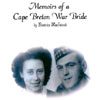|
Home
> War
Bride Stories > Beatrice (Davidson) MacIntosh
 |
| The front cover of Beatrice MacIntosh's "Memoirs of a Cape Breton War Bride". |
Memoirs of a Cape Breton War Bride
by Beatrice (Davidson) MacIntosh
Cape Breton War Bride Beatrice MacIntosh has written her life story and kindly sent us a copy of her privately published memoirs in PDF format. Click here to download the entire document in PDF format [4.64 mbs]. For a glimpse at the first few pages, please read her story below.
My hometown was London England. I was born in 1924 to Tom and Mary Davidson. We were a family of seven children. I had three brothers and three sisters.
I was fifteen years old when the 2nd World War broke out. The year was 1939. I had already worked a year with Dun and Bradstreets. I had started at the age of fourteen, which at our school was the leaving age, unless we wanted to further our education. I had started night school for shorthand-typing but school children were evacuated out of London once the war started. My two younger brothers and sister were sent away to safer places – like so many other children without their parents, and although they had an idea where the children were sent to, they never really knew for sure. The office I worked at was on the west side of London Bridge, over the Thames River, with its docks and wharves underneath, and barges and boats of every description.
The pool of London was a very busy spot and a prime target for the German bombers. Even so, life seemed very simple the first year of the war and I happily walked back and forth to work every day. I was sure I would always live in London, but war changed all that.
In 1940 I was 16 years of age. Up to this point we had suffered through a few air raids, but in September, the “Blitz of London” started. The Blitz was so named when the Germans decided to destroy London. We suffered through nine months of constant bombing, both night and day, running back and forth to Air Raid Shelters, or staying home and sitting under the wooden kitchen table, praying and hoping we would live to see another day – it was hell for sure. So much death and destruction. It would be difficult to write a day by day account, but it quickly became evident that the long threatened Blitz by Germany had commenced!
I continued working and at times was caught on London Bridge when the planes would swoop low to machine gun us. At work, when the sirens went off, we all trooped down to a wharf under the building and stayed there until the “all clear” sounded and then we went back upstairs to work.
The 10th of May was one of our worse nights. The Germans decided to finish London. Thousands of bombers dropped high explosives and incendiary bombs. London was a mass of flames. There were a thousand fire engines and pumpers in London that night battling the fires. The next day it was hard to walk on the streets with hoses everywhere, but we still trudged off to work; thankful to be alive and have a job to go to.
Times were very hard and we knew the Germans were encamped across the channel, ready to invade Britain. Image how thankful we were when the USA declared war after Pearl Harbour and they marched into Britain. That was the winter of 1941/1942 and the war was still raging.
I was anxious to get into war work as soon as I turned eighteen in June 1942. Dad would not consent to me joining the Woman’s Forces, so I decided to join the NAAFI. (Navy, Army and Air Force Canteen Service for the Troops). I was sent to Aldershot, a large military town with a Canadian Division of a hundred thousand troops, plus the British troops. It was a very busy, crowed town. I was issued a khaki uniform with a pork pie hat, blue overalls and a cap for inside. Except for the hat, we were dressed like the A.T.S. (Auxiliary Territorial Service, Army Ladies). I worked in several canteens but eventually went to Salamanca Barracks; a training barracks, and that was when fate stepped in…
When I first heard this was a Canadian Barracks I was very nervous. I wondered if I should run back home but I was committed, and had signed a contract. The girls there were very friendly and the supervisor, an older lady, was very strict, but fair.
She had worked in the NAFFI in the 1st World War and she had been called back. There were 12 girls all together and 4,500 soldiers in the barracks. Our canteen was right in the centre of the barracks, with the canteen downstairs and our living quarters upstairs.
I met Kendrick the Fall of ’42. He was a Training Instructor, training drivers for Bren Gun Carriers, which was a small armed tank. The boys would all come into the canteen at lunch time and again in the evenings for cigarettes, etc. We were very busy but were friendly with them all.
We had a half day off each week, one weekend every three weeks and a few hours every afternoon. Normally we started early in the morning and worked till ten o’clock at night, except when there was a dance in the camp – then we served refreshments and stayed open later. The dance hall was across from the canteen.
Of course, girls were scarce and we were in demand, so we cleared up quickly and were able to spend some time at the dance. The camp would send trucks out to surrounding areas to bring girls in and take them back later. They needed girls to dance with the guys.
Kendrick never danced, but he would come to the hall and we would talk and get to know each other better. Our first date was planned for New Year’s Eve, 1942-43, when I was eighteen and he was twenty-one. I was sorry to hear it was put off because they had to go on a scheme for two days. He sent a friend to apologize so then I took myself off to a New Year’s dance at another barracks, where I was welcomed with open arms. Girls were very few and far between. I had a wonderful evening. I walked back to our camp by myself, never worried about walking alone because there were many security guards around camps who watched us girls closely.
We finally did have many dates, and I took Ken home to London to meet my Dad and Sisters. (My mother had taken my younger brothers and sister out of London to a safe area). Dad really liked my “Scottish Canadian”, as Dad had put it. He had been in the Royal Scots Regiment in the 1st World War and so anybody Scottish must be a good person.
Ken knew London well. Most of the Canadian troops would go to London, Scotland or Manchester on their weekend passes. They would stay at the Beaver Club or the Salvation Army Hostel in London, where they were always welcome. It would cost them a few shillings to stay there but they were never turned away even if they didn’t have any money. I have a high regard for the Salvation Army to this day for the wonderful treatment they gave to our troops. London was a very gloomy city with all the destruction and devastation and also very crowded, with troops from everywhere. Food was scarce, but the people remained cheerful and very friendly in spite of it all.
During this time, Ken talked a lot to me about Canada and his home. I still didn’t understand what it really was like, so when my darling Canadian asked me to marry him and go back to Canada with him, I really didn’t know what to say, I loved him, but the thought of leaving my family and friends … I wasn’t sure.
With the way the war was raging, we didn’t dare make plans for the future. Then the year “44 entered and Germany unleashed their new secret weapon, “the Buzz Bomb,” which was named by the British, “The Doodle Bug.” It came from France –unmanned (no pilot) and targeted for London.
We heard it stop, (it came so fast) and then it came down. There were mostly two Doodle Bugs together, so we would lay down flat on the street, wherever we were or dodge into a doorway or whatever. Frightening for sure!
All our Canadians in our camp were then transferred up to the North of England for more training. Of course Kendrick went too – he was the Training Instructor. It was good-bye once again. Something big was happening – the British, Polish, Dutch and French troops all moved into our camp. The foreign troops etc., had escaped from their own countries once the Germans had moved into theirs, and they wanted to join the Allies to fight against the Germans.
It was at that time Kendrick and I talked about being married later in the year. Before he left Aldershot, he took me to see the R.C. Padre in the camp. The Padre wasn’t in favor of us thinking of marriage, very much against it in fact, because we were of different religions. He was a French Canadian Priest and was very rude and opinionated. I had thought I would change my religion, but he didn’t seem to approve of that either.
My Dad had given us his blessing when Kendrick spoke to him, although I had wondered about the Catholic side, but my Dad was impressed with Kendrick because he was in the Scottish Regiment and his people were of Scottish decent. My Dad was in the “Royal Scots Regiment” in the 1st World War and very proud of his Scottish roots.
While on one of my weekend trips to London, I decided to buy my wedding outfit. I had begged and borrowed enough clothing coupons for a suit, hat, shoes, etc., and I left them at my home in London, so sure if it all worked out for us we would be married there. I missed my darling Canadian and wrote to him every day even though I knew our letters were being censored when they left the barracks as well as any being mailed to me. A few officers of the Canadian regiment had remained when the rest had been moved out and we had to take our mail over to them. I am sure when they read my letters; they must have had a chuckle.
We were confined to barracks and warned not to speak of anything. We knew something big was happening, as we watched the movement of the troops and the war planes overhead, so we were not surprised about D-day on June 6, 1944. The British were all moved out of our camp and our Canadians were moved back in; all prepared for the big fight in Europe. Most of them were reinforcements for the 1st Division. One morning we were awakened at three o’clock to open the canteen to serve coffee, tea, cigarettes, etc. to the boys as they were leaving. It was sad to say good bye as we knew so many would never return...Click here to download the entire document in PDF format [4.64 mbs].
Back to Top
|
 |




